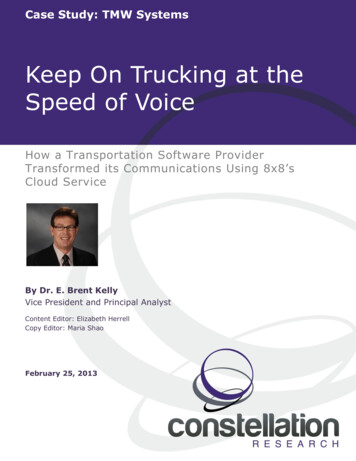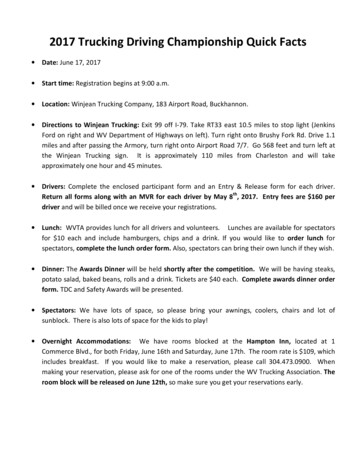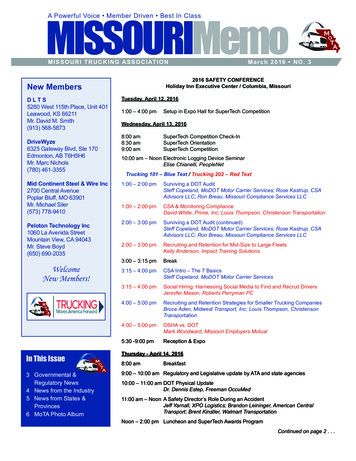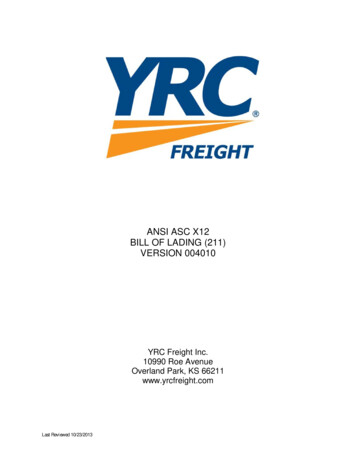
Transcription
Case Study: TMW SystemsKeep On Trucking at theSpeed of VoiceHow a Transportation Software ProviderTransformed its Communications Using 8x8’sCloud ServiceBy Dr. E. Brent KellyVice President and Principal AnalystContent Editor: Elizabeth HerrellCopy Editor: Maria ShaoFebruary 25, 2013
Problem Solution Benefits TMW Systems faced many problems getting its Cisco-basedtelephony and UC solution to work properlyCall quality was often poor and fixes were costlyEquipment on a long-term capital lease would not run newsoftware versions with updated capabilitiesTMW looked at cloud communications services as a way tosimplify IT operations and move to an OPEX rather than CAPEXmodelTMW selected 8x8’s Virtual Office ProMuch higher call quality along with better internal and externalcustomer serviceLower costs and a shift to consistent OPEX spendingSignificantly reduced IT department’s telecommunicationsworkloadCommunications is the lifeblood of the commercialfreight logistics business. TMW Systems Inc. is one ofthe global leaders in the industry, providingtransportation and logistics software and services to2,300 customers, including for-hire carriers, dedicatedtrucking fleets, third-party logistics providers andfreight brokers. In addition, the company’s software isused by private fleets in the ndlingbusinesses and by several municipal governments.TMW’s customers manage over 71 billion in freightlogistics and transportation spending annually, and thecompany’s software directs approximately 510,000trucks throughout North America, Latin America,Europe, and Australia/New Zealand. TMW Systems is awholly-owned subsidiary of Trimble Navigation Ltd.(FY2012 revenues of U.S. 2 billion, NASDAQ:TRMB). 2013 Constellation Research, Inc. All rights reservedCompany: TMW Systems Inc.Headquarters: Cleveland,Ohio2012 Revenue: 2 billion(parent company)No. Employees: 500Industry: TransportationLogisticsOther: Founded in 1983.Eleven branch offices.Subsidiary of TrimbleNavigation Ltd.(NASDAQ:TRMB)2
Although TMW Systems was a 30-year-old company by 2013, it had experienced rapidgrowth, both organically and through acquisitions. The company had a Cisco InternetProtocol (IP) telephony solution, financed by a long-term capital lease. This systemconsisted of centrally located communication manager servers, voice messaging servers,an Instant Messenger/presence server and a Web conferencing server. The remotelocations were outfitted with Cisco Survivable Remote Site Telephony (SRST) gatewaysthat provided local calling in the event of a network outage between the remote site andheadquarters. To provide high availability, TMW provisioned a diesel generator at thecentral site that would power the IT and telephony infrastructure should there be anelectrical service interruption.The company was in high-growth mode, acquiring five complementary softwarecompanies over six years. Each company brought its own communications system andnetwork which had to be replaced with the Cisco networking gear and telephones in orderto get a uniform communications environment. Each location required specialconfiguration of its routers, and a hub-and-spoke multiprotocol label switching (MPLS)network connected the entire system together.“No single person on the ITstaff understood how it allworked. Not only was there ITcomplexity, there was alsoTelco complexity.”Ron Godine,Director of ITTMW SystemsThis system was very complicated. Although TMW hadfour Cisco-certified IT professionals on its staff, no onefully understood how the entire system worked or howto operate and maintain it. Without telecom specialists,TMW required expensive outside services to provisionnew users and to make communications servicechanges. The very act of provisioning required logginginto multiple management interfaces just to make anew phone and unified messaging work together.TMW also reported that it always seemed to have voicequality of service (QoS) problems. It was not that the equipment was defective; it wasjust that TMW experienced major problems getting all of the elements to all work togethercorrectly. Small changes required router reboots, which sometimes caused other settingsto change, which in turn hurt QoS.Two Events Leading To ChangeTwo events occurred that caused TMW to reconsider its telephony and messaginginfrastructure. The first involved the company’s capital lease on the Cisco equipment.After three years of leasing the equipment, TMW discovered that upgrades with newfunctionality would not run on its existing servers and that the company would not onlyhave to upgrade the software, but it would have to upgrade the hardware as well.The second event occurred in 2010, when a serious ice storm gripped Cleveland, causinga regional power outage. Under TMW’s disaster recovery plan, a generator at 2013 Constellation Research, Inc. All rights reserved3
headquarters came online to continue to power the lights and the IT and telephonysystems. Unfortunately, after about 10 minutes, a cooling hose broke on the generator:The uninterruptible power supplies slowly discharged, and TMW was withoutcommunications for several hours.Compounding the problem was the configuration of the Cisco SRST gateways at theremote locations. The network between the gateways and headquarters was down. But,only local calls could be made using the SRST gateways, not long distance calls. Without alink between remote sites and headquarters, TMW’s entire business operations, in effect,went down. Even those with smartphones on their PCs could not make calls becauseheadquarters, where these smartphones registered for telephony services, was down.TMW is the first to admit that this systemwide outage was not the fault of the telephonyequipment it had, but was caused in part by how the equipment was configured, and inpart by the bad luck of a double failure of the regional power grid and the headquartersgenerator.A failed disaster recovery capability, coupled with a long-term capital lease that lockedTMW into old hardware or an expensive hardware upgrade, caused the company torethink its communications strategy.In 2011, TMW began looking at cloud-based unified communications (UC) solutions. Cloudsolutions seemed compelling because they offered better disaster recover capabilities plusthey were clearly, in TMW’s view, a bold way to embrace the future. This decision topursue cloud offerings was made jointly by the CEO, the CFO and the IT director, all ofwhom knew the risks and all of whom were quite technical.The first option the company looked atwas PingTone. That provider offered totakeTMW’sexistingCiscocommunications servers, host them in aPingTone data center, and operate and8x8 Virtual Office Promanage them. Connectivity would still beRedundant public Internetby dedicated MPLS circuits providing aconnections.hub-and-spoke network configuration.TMW ultimately rejected this solution forPolycom phonesa number of reasons: It seemed verysimilar to what TMW already had; the existing Cisco infrastructure was retained; the costswould be more than what TMW was already paying; and it wasn’t really a bold step thatwould move TMW closer to its vision of moving to the cloud.Four other solutions - from AT&T, Allworks (PAETEC), Jive and CoreDial - were evaluatedbut eventually rejected. TMW ultimately chose 8x8’s Virtual Office Pro offering. 2013 Constellation Research, Inc. All rights reserved4
TMW found that 8x8 was determined, aggressive on making sound business argumentsand could provide savings while offering capability improvements. In addition, thissolution solved some of the disaster recovery issues TMW was so keen to overcome; 8x8’soffering is geographically redundant, meaning that if one 8x8 data center goes down forany reason, the solution continues to function from another data center (8x8’s redundantdata centers are located in Ashburn, Va. and in Silicon Valley).The deployment was a little rocky at first. TMW learned that its network infrastructureneeded some upgrading in order to provide good QoS. In addition, the company learnedthat bandwidth control is critical even on the local area“I loved providing the usersnetwork (LAN), and certainly on the wide areathe tools and flexibility thatnetwork (WAN). The 8x8 executive team was verymade them as productive asresponsive to TMW’s needs, stepping up to helpthey could be.”resolve rollout issues.Ron Godine,The 8x8 solution does not use, nor does it require,Director of ITMPLS circuits; voice traffic flows over the publicTMW SystemsInternet. TMW reported that it initially had someproblems with call quality, due to outbound Internet bandwidth constraints. These weresoon resolved. Furthermore, to provide high availability, TMW deployed redundantInternet connections at each location through different carriers/providers in order to avoida single point of failure. The main connection is with a Tier 1 Internet Service Provider andthe secondary connection is through local DSL or cable connections.The year 2011 was a learning and rollout year for TMW. By 2012, there were noremaining issues, and all users, particularly those on“The 8x8 help desk is like thethe executive team, were very responsive and‘12th man’ on our IT staff theenthusiastic about the cloud solution based on 8x8’slevel of diagnostics theyservices. Taking the capital lease out of the equationprovide is something we haveand replacing it with monthly operating expenses hasnever had before.”been key to the successful rollout.Ron Godine,Director of ITTMW Systems8x8’s offering also provided some capabilities that TMWdid not have with its previous system, such as singlenumber reach, a single voicemail box and softphonecapability for everyone1. In addition, users had muchmore control over their own communications and settings through 8x8’s Virtual Office Proportal.New users are now easy to provision, and adding a new user does not require adding anyinfrastructure, special licensing or multiple management tool configurations. TMW1The company had unified messaging, but apparently did not purchase Cisco’s single numberreach capability. Also, TMW referenced Cisco softphone capabilities, but with 8x8, every userreceived one versus a limited number of users with Cisco’s solution. 2013 Constellation Research, Inc. All rights reserved5
considers 8x8 “our voice carrier” and has likened the 8x8 help desk to the “12th man”2 onthe staff. Should there be a problematic call, it can be recorded in real time and the 8x8help desk can triage what happened on the call. The help desk can show step by step,device by device, how the call was routed and pinpoint where issues were that may havecaused call quality degradation. In fact, the help desk even detected a problem in a TMWcustomer’s router configuration after it proved, using its diagnostics capabilities, wherethe problem was located.1. Proper network design is critical for enabling QoS in any IP communicationssolution, regardless of whether it is premises-based or cloud-based.2. Even well-conceived disaster recovery plans can go awry. Single point-of-failuresystems do have higher risk, and a well-designed cloud-based solution withinherent georedundancy can significantly reduce risk.3. A high-quality voice solution can be implemented without costly MPLS point-topoint connections. TMW uses the public Internet for all of its voice traffic.4. Redundant network connections through different carriers is important for ensuringhigh system uptime.5. A cloud-based communications solution can significantly reduce the IT overheadrequired to operate and maintain a unified communications system.6. Total cost of ownership is not the only criteria to look at when choosing acommunications system. Other considerations include georedundancy, theavailability of the proper skill set, using an OPEX funding model versus a CAPEXmodel, reduced complexity, and the current trend of moving non-core IT andtelecom solutions to the cloud.2The 12th man refers to a football legacy at Texas A&M University. In 1922, when teams had fewermembers than today, injuries shrank the Texas A&M football team to only 11 players. A studentcame out of the stands, suited up and was ready to play if needed, thus launching one of therichest legacies in college football. 2013 Constellation Research, Inc. All rights reserved6
About Constellation ResearchConstellation Research explores the technologies and business models that not onlydisrupt established players, but also create transformational innovation. We share ourresearch insights with business leaders seeking more than just rubber stamp approval orrearview mirror confirmation by traditional legacy analyst firms. Every piece of researchbegins by understanding how to deliver business value, applying real world experienceand insights and incorporating disruptive technologies and innovative business models asappropriate. Our mission is to identify, validate and share these insights with our clients.As a result, our research community includes members of boards of directors, C-suiteexecutives, line of business leaders and IT visionaries who are not afraid to challenge thestatus quo. Most of our clients share a common trait - the passion for learning,innovating and delivering impactful results.Organizational Highlights Founded and headquartered in the San Francisco Bay Area, United States, in 2010.Named Institute of Industry Analyst Relations (IIAR) New Analyst Firm of the Yearin 2011.Serving over 170 buy-side and sell-side clients around the globe.Experienced research team with an average of 21 years of practitioner,management and industry experience.Creators of the Constellation Supernova Awards - the industry's first and largestrecognition of innovators, pioneers and teams who apply emerging and disruptivetechnology to drive business value.Organizers of the Constellation Connected Enterprise - an innovation summit andbest practices knowledge-sharing retreat for business leaders.Website: www.ConstellationRG.comContact: info@ConstellationRG.comTwitter: @ConstellationRGSales: sales@ConstellationRG.comUnauthorized reproduction or distribution in whole or in part in any form, including photocopying, faxing, image scanning, e-mailing, digitization, or makingavailable for electronic downloading is prohibited without written permission from Constellation Research, Inc. Prior to photocopying, scanning, and digitizingitems for internal or personal use, please contact Constellation Research, Inc. All trade names, trademarks, or registered trademarks are trade names, trademarks,or registered trademarks of their respective owners.Information contained in this publication has been compiled from sources believed to be reliable, but the accuracy of this information is not guaranteed.Constellation Research, Inc. disclaims all warranties and conditions with regard to the content, express or implied, including warranties of merchantability andfitness for a particular purpose, nor assumes any legal liability for the accuracy, completeness, or usefulness of any information contained herein. Any reference toa commercial product, process, or service does not imply or constitute an endorsement of the same by Constellation Research, Inc.This publication is designed to provide accurate and authoritative information in regard to the subject matter covered. It is sold or distributed with theunderstanding that Constellation Research, Inc. is not engaged in rendering legal, accounting, or other professional service. If legal advice or other expertassistance is required, the services of a competent professional person should be sought. Constellation Research, Inc. assumes no liability for how this informationis used or applied nor makes any express warranties on outcomes. (Modified from the Declaration of Principles jointly adopted by the American Bar Associationand a Committee of Publishers and Associations.)Andalucia Belfast Boston Chicago Colorado Springs Denver Geneva Irvine London Los Angeles Madrid New York Pune Sacramento SanFrancisco Santa Monica Salt Lake City Sedona Sydney Tel Aviv Tokyo Toronto Washington D.C. 2013 Constellation Research, Inc. All rights reserved7
Europe, and Australia/New Zealand. TMW Systems is a wholly-owned subsidiary of Trimble Navigation Ltd. (FY2012 revenues of U.S. 2 billion, NASDAQ:TRMB). Company: TMW SystemsInc. Headquarters: Cleveland, Ohio 2012 Revenue: 2 billion (parent company) No. Employees: 500 Industry: Transportation Logistics Other: Founded in 1983.











